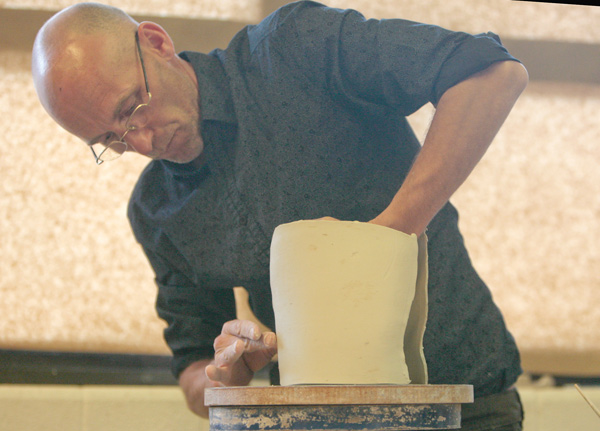Russian native shows sculpting talent at YSU workshop


Russian native Sergei Isupov demonstrates the proper sculpting technique Wednesday in Bliss Hall at Youngstown State University. Isupov, who now resides in Massachusetts, explained how each of his sculptures, which often are covered in bright, detailed paintings, offer a unique experience for all involved.
Staff report
YOUNGSTOWN
As the slabs of clay that lay before him gradually morphed into a human face, ceramic artist Sergei Isupov politely chatted with the crowd before him.
The Russian native explained how each of his sculptures, which often are covered in bright, detailed paintings, offer a unique experience for all involved.
“Not every piece has a clear story,” said Isupov, 50, of Massachusetts, “If I knew the exact story, I would be a writer. I just put symbols and let people interpret.”
On Wednesday, Isupov offered a free workshop, and later a lecture and hands-on experience, at Youngstown State University as part of the university’s art department lecture series.
In front of roughly 30 people, Isupov provided a quick demonstration of his skills and offered advice.
Missy McCormick, an assistant professor of art, said bringing Isupov to campus exposed students and the community to a wide variety art and culture.
“He works with clay, but he is also a painter,” said McCormick. “His processes and approaches incorporate a variety of mediums. He is a very versatile artist and really draws people into his work.”
In addition to bright colors and symbolism, Isupov also incorporates sexuality into his pieces.
“It is so hard to get attention,” he said, “That’s why I use sexuality.”
Isupov, who sketches his work before sculpting, said his inspiration for his pieces come from “everyday life” and his Russian influence.
“My pieces are very narrative, and [that comes from me being a] foreigner. ... In the Russian culture, narrative is more important. Art and religion was portrayed through painting, drawing and storytelling,” he said. “Now, everything influences me. Each day gives me a new idea.”
In addition to the elaborate artwork on the sculpture, he also hides paintings or tiling on the bottom of his artwork.
“It is the private part of the work,” he said. “It’s not supposed to be seen.”
When Isupov came to the United States in 1993, he did not speak English.
“It was difficult to communicate,” he said. “But I was able to talk symbolic with art.”
Exposed to both clay and painting at a young age by his artist parents, Isupov said he never had a desire to work in other art forms.
“Clay gives me rules compared to painting, which gives me more freedom. I switch between the two depending on what is needed.”
Isupov attended the Art Institute of Tallinn in Estonia and the Ukrainian State Art School. After building a name for himself overseas, he came to the U.S. in search of new opportunities and challenges. Isupov said he focuses on one piece at a time but prepares several sculptures at once to allow the clay to harden and to have a fresh canvas on hand.
Isupov could not recall the cost of an average piece of his work but said his most expensive sculpture fetched roughly $60,000.
He said he rarely offers workshops, maybe two or three each year, but decided to come to YSU to experience the area.
“I’m not trying to teach; that’s not my role,” he said. “They got lucky. I have never been here.”
Wednesday’s sculpture depicted a theme he chose only moments before sculpturing: Two people drowning.
“One person will survive; the other will drown,” he said as he sculpted the head of his sculpture into a boat. “I make things up as I go.”
Shannon Clark, a photography senior at YSU, sat as Isupov worked.
“It’s amazing,” said Clark, 26, who is taking a ceramics class. “I’m struggling right now in class, and his work makes me want to learn to do things right. Plus his work is really relatable.”
 43
43
